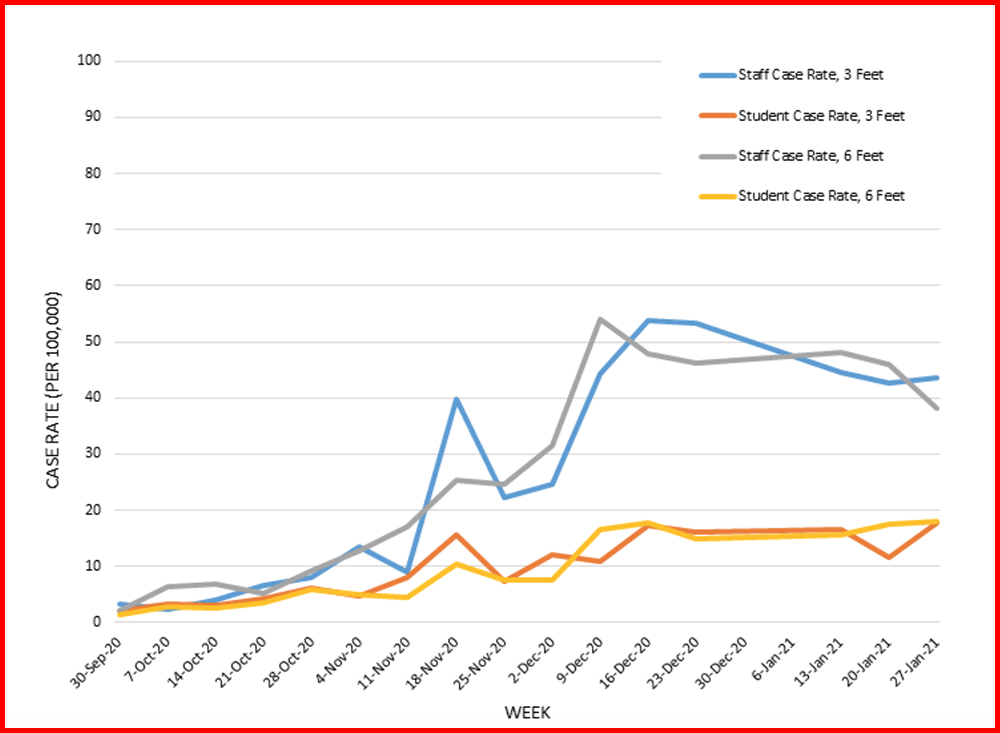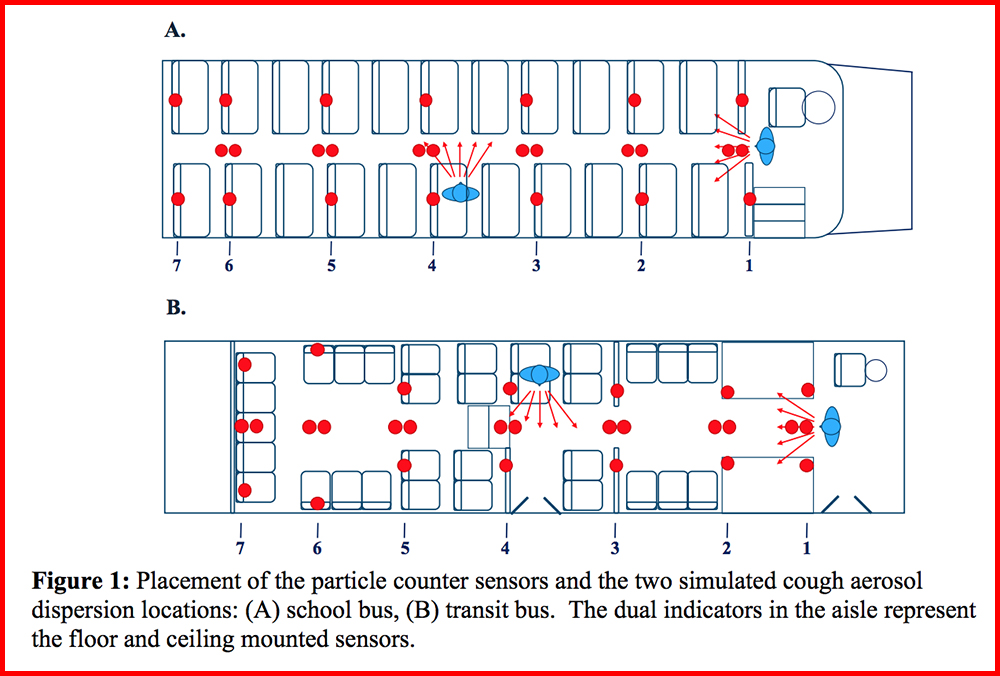The Week in COVID & Education Policy: 17 Key Updates on Schools, Students and New Data Surrounding Social Distancing in Classrooms

This is our weekly briefing on how the pandemic is shaping schools and education policy, vetted, as always, by AEI Visiting Fellow John Bailey. Click here to see the full archive. Get this weekly roundup, as well as rolling daily updates, delivered straight to your inbox — sign up for The 74 Newsletter.
New Distancing Data — 3 Ft. vs 6 Ft. in the Classroom: New study out this week on classroom distancing, from a number of researchers, including Emily Oster. Findings:
- The researchers examined 251 school districts in Massachusetts serving 537,336 students and 99,390 staff who attended in-person instruction during a 16-week study period. (Represents 6,400,175 student learning weeks and 1,342,574 staff learning weeks)
- “Student case rates were similar in the 242 districts with ≥3 feet versus ≥6 feet of physical distancing between students”
- Conclusion: “Lower physical distancing policies can be adopted in school settings with masking mandates without negatively impacting student or staff safety.”
- More background in this Massachusetts presentation.
March 12, 2021 — The Big Three
Classroom vs. Community Spread in New York City Schools: Researchers analyzed data from 234,132 persons tested for SARS-CoV-2 infection in 1,594 New York City public schools during Oct. 9-Dec. 18, 2020
- “During eight weeks of in-person school, we found that persons associated with public schools had an overall burden of COVID-19 infections that was no higher than the burden in the general community and that transmission within schools was not common”
- “Overall incidence was higher for staff than the general community and markedly higher for persons aged 45-64 years and 65-74 years during December. The fact that prevalence remained similar to or less than model estimates for persons 18-64 years old, however, suggests that increased incidence was attributable to increased ascertainment of infection—staff were tested at far higher rates, including 10 times the rate in December, than adults in the community—or acquisition of infection outside of school settings because of rising community incidence.”
- “When strict protocols were implemented for preventing, diagnosing, and managing school-associated cases, in-person learning in public schools was not associated with increased prevalence and incidence overall compared with the general community, and secondary transmission was infrequent.”
How Does COVID Spread on School Buses?: New study on air circulation in buses:
- “This study demonstrates that wearing of masks reduced the overall particle count released into the bus by an average of 50% or more depending on mask quality and reduced the dispersion distance by several feet.”
- “The study also demonstrates an 84.36% reduction in aerosol particles and an 80.28% reduction in the mean aerosol residence time for some test cases.”
- “The optimal air exchange configuration of all windows and accessible roof hatches along with dashboard fans resulted [in]… significant reductions in the overall particle count.
- “By adding the retrofit MERV-13 air filters to the HVAC return air vent in the back of the transit bus, the effectiveness of removing aerosol particles increased significantly. The resulting particle count AUC with the air filters resulted in an average of 93.95% improvement with aerosols dispersed from a middle location during bus in-motion testing.”
130 Studies Related to School Reopenings: The COVID Collaborative, United States of Care, the Walton Family Foundation, Opportunity Labs, the Evidence Project, and AEI released a report that summarizes more than 130 studies related to school reopenings. Some toplines:
- The vast majority of research from around the world suggests that children comprise a small proportion of diagnosed COVID-19 cases, develop less severe illness, and have lower mortality rates. Attending school does not increase risk to children, particularly if health protocols are followed.
- Evidence points to schools mirroring the transmission rates of their communities. Schools themselves do not appear to drive community transmission.
- Protective measures such as mask wearing, physically distancing, increasing hygiene regimens, and improving ventilation add layers of protection that can mitigate risks for students and school staff. COVID-19 vaccinations, symptomatic testing and isolating potentially infected individuals, and asymptomatic COVID-19 screening tests offer additional preventive benefits.
- A growing number of studies are giving us a picture of the “costs” of remote learning in terms of learning loss which will translate into earnings loss; increased mental health challenges; and more than 1.7 million mothers who left the workforce due to school closures. These costs have to be weighed against any public health benefit associated with closing schools.
- Go Deeper: The 74’s Linda Jacobson offers a breakdown of key findings — “Collection of 130 COVID Studies Aims to Give Schools a ‘Solid Grounding’ to Reopen”
COVID-19 Research
Researchers Claim CDC Misinterpreted Their Study: The authors of a CDC study of Wisconsin schools wrote an oped in USA Today — “CDC misinterpreted our research on opening schools. It should loosen the rules now.”
- “Viral spread is minimal in schools with appropriate safety precautions, even in communities with a high disease prevalence (significantly higher than the CDC red zone that the CDC suggests middle and high schools be all virtual and elementary schools hybrid).”
- “Dr. Hoeg led a study of 4,876 grade K-12 students and 654 staff members in Wisconsin school districts last fall. COVID-19 test positivity rates reached 41.6% in the community during the study. Notably, despite the majority of ventilation systems not being replaced, with 92% of students wearing masks (no mask wearing during recess), and with variable distancing, there were only seven students (five children grades K-6, and two in grades 7-12) and zero staff who contracted the virus in school.”
- “No science supports mandating 6 feet of distance with children wearing masks. A 6-foot distance between students creates space constraints for schools to open in entirety. There is data supporting at least 3-foot distancing.” (Read the full essay)
COVID Children Cases May Be Higher: A CDC-supported study in Mississippi found the actual number of children infected with the virus that causes COVID-19 might have been much higher than the number of cases reported.
- Serologic testing of residual blood specimens collected during May-September 2020, from 1,603 children under the age of 18 suggests that approximately 113,842 (16.3%) of 698,420 young persons in Mississippi might have been infected with SARS-CoV-2 by mid-September 2020.
- However, only 8,993 confirmed and probable cases had been reported.
Tutoring: NBER paper on impact of Saga Education’s tutoring. Findings:
- “Relatively low cost ($3,500 to $4,300 per participant per year tutoring).”
- “Saga tutors neither had formal teacher training nor were licensed Illinois teachers.”
- Students who received Saga tutoring learned as much as an extra two and a half years of math in one academic year.
- More from U. of Chicago Urban Labs and The 74.
Reading Loss: Policy Analysis for California Education released a new study that examined 250,000 oral reading fluency scores for students in first through third grade last spring and fall in over 100 school districts across 22 states.
- They found yearly gains in oral reading fluency were 26% lower than expected based on prior years for the second-graders and 33% lower for the third-graders.
The National Student Support Accelerator: Launched a new website that includes a summary of current tutoring research, a toolkit to make it easy to launch a new tutoring program or improve an existing tutoring program, and a tutoring program database, along with updated information on the Accelerator’s pilot sites and state-level policy recommendations.
City & State News
California: LA teachers union reaches tentative deal with LAUSD to reopen school in mid-April.
- “Under the plan, preschoolers would have full-day in-person instruction, while elementary schoolers will use a hybrid model combining some time in class and the rest online … class sessions will be staggered, with some students going in the morning and others in the afternoon … students in middle and high schools will continue learning online, although they can return to campus ‘for peer interaction, social-emotional learning and lessons for college and career exploration.’”
New Jersey: An optional exam that 90,000 New Jersey students took this fall suggests that roughly 1 in 3 may need “strong support” academically.
Alabama: The Summer Adventures in Learning (SAIL) is providing nearly $1 million in funding to more than 50 summer learning programs across the state.
Maine: The number of children between the ages of 5 and 11 going to the emergency room for mental health-related issues has increased 24% since the start of the pandemic.
Illinois: New state guidance for in-person instruction allows schools to operate with three feet of distancing.
9 States Awarded Grants to Accelerate COVID-19 Workforce Recovery Efforts: The National Governors Association announced Alabama, Arizona, Colorado, Hawaii, Maine, Missouri, New Mexico, Nevada and Washington as the inaugural cohort of states in the Workforce Innovation Network
Viewpoints
‘When Will It End?’: Reuters interviewed18 specialists who are tracking the pandemic
- “Many described how the breakthrough late last year of two vaccines with around 95% efficacy against COVID-19 had initially sparked hope that the virus could be largely contained, similar to the way measles has been.”
- “But, they say, data in recent weeks on new variants from South Africa and Brazil has undercut that optimism. They now believe that SARS-CoV-2 will not only remain with us as an endemic virus, continuing to circulate in communities, but will likely cause a significant burden of illness and death for years to come.”
- “Murray said if the South African variant, or similar mutants, continue to spread rapidly, the number of COVID-19 cases resulting in hospitalization or death this coming winter could be four times higher than the flu.”
Rockstar: Rolling Stone on How Economist Emily Oster Ended Up at the Center of the Fight Over Schools Reopening
- “With CDC data now available from one full semester of schools in a range of states, employing a range of mitigation strategies, it seems that Oster was largely correct when looking at the early data from the dashboard in October: Schools have not been associated with substantial community transmission.”
One Year In, Innovative Approaches to Learning During a Pandemic: Reflections from NSVF’s Miho Kubagawa:
- “Parents, especially those from underserved communities, will keep demanding change. Educators and schools that fully engage parents as true partners in this new reality will unlock ways to support and accelerate student learning.”
- “The pandemic has laid bare the disconnect between what students are asked to do and the relevancy or meaning that these tasks have on their lives.”
…And on a Lighter Note
Mama, Can I Get a Kitty? Asks this puppy:
@moonpie.starboxTY @tiredmamateacher !!
ICYMI @The74
Weekend Reads: In case you missed them, our top five stories of the week:
- Declining Enrollment: FAFSA applications fell after COVID — and for many incoming freshmen, they haven’t recovered (Read more)
- Student Engagement: A high school in Ohio is giving students a choice — Keep up with remote learning or you have to come back to the classroom (Read more)
- Teacher Diversity: Colorado district uses high school apprentices to grow its own more diverse teacher workforce (Read more)
- Parent Activism: ‘This is crushing our children’ — New Jersey parent leader explains why some families are suing to get their schools reopened (Read more)
- Tutoring: New study shows Chicago tutoring program delivered huge math gains; personalization may be the key (Read more)
Disclosure: John Bailey is an adviser to the Walton Family Foundation, which provides financial support to The 74.
Get stories like these delivered straight to your inbox. Sign up for The 74 Newsletter

;)


